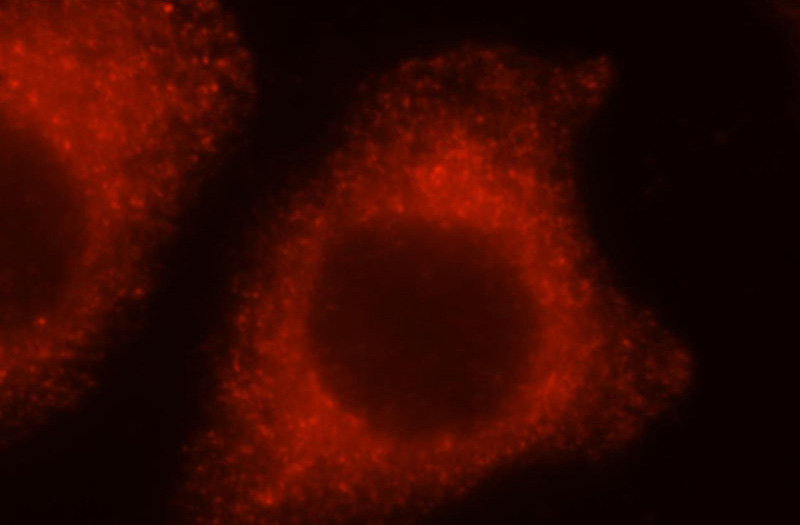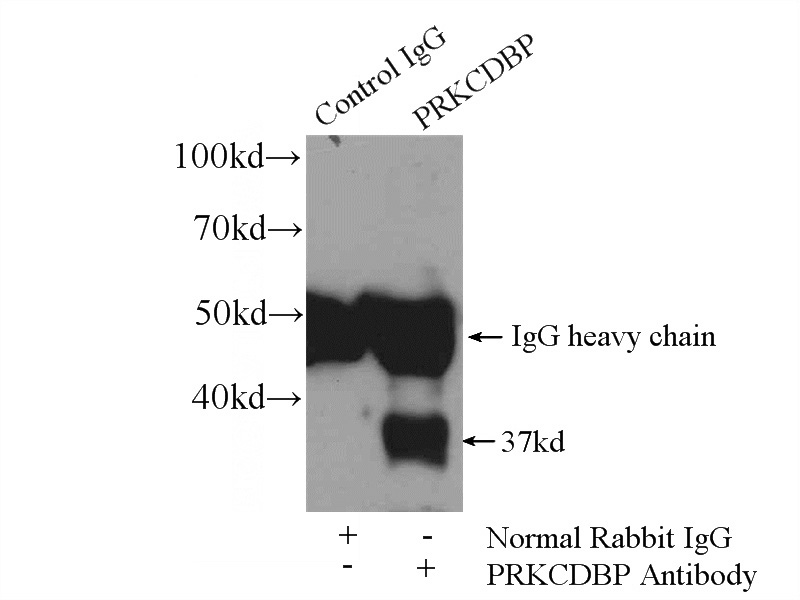-
Product Name
PRKCDBP antibody
- Documents
-
Description
PRKCDBP Rabbit Polyclonal antibody. Positive IHC detected in human lung cancer tissue. Positive IF detected in MCF-7 cells. Positive IP detected in mouse lung tissue. Positive WB detected in mouse lung tissue, MCF7 cells. Observed molecular weight by Western-blot: 35-40kd
-
Tested applications
ELISA, WB, IHC, IF, IP
-
Species reactivity
Human,Mouse,Rat; other species not tested.
-
Alternative names
Cavin 3 antibody; HSRBC antibody; PRKCDBP antibody; SRBC antibody
-
Isotype
Rabbit IgG
-
Preparation
This antibody was obtained by immunization of PRKCDBP recombinant protein (Accession Number: NM_145040). Purification method: Antigen affinity purified.
-
Clonality
Polyclonal
-
Formulation
PBS with 0.02% sodium azide and 50% glycerol pH 7.3.
-
Storage instructions
Store at -20℃. DO NOT ALIQUOT
-
Applications
Recommended Dilution:
WB: 1:200-1:1000
IP: 1:200-1:2000
IHC: 1:20-1:200
IF: 1:10-1:100
-
Validations

mouse lung tissue were subjected to SDS PAGE followed by western blot with Catalog No:114199(PRKCDBP antibody) at dilution of 1:400

Immunohistochemical of paraffin-embedded human lung cancer using Catalog No:114199(PRKCDBP antibody) at dilution of 1:100 (under 40x lens)

Immunofluorescent analysis of MCF-7 cells, using PRKCDBP antibody Catalog No:114199 at 1:25 dilution and Rhodamine-labeled goat anti-rabbit IgG (red).

IP Result of anti-PRKCDBP (IP:Catalog No:114199, 4ug; Detection:Catalog No:114199 1:600) with mouse lung tissue lysate 2800ug.
-
Background
Protein kinase C delta-binding protein (PRKCDBP) is a putative tumor suppressor in which alteration has been observed in several human cancers. It is a BRCA1-interacting protein, and may also be involved in DNA damage response and participate in BRCA1-mediated tumor suppression pathways. PKCdelta binds to the C-terminal half of PRKCDBP through the regulatory domain and phosphorylates it in vitro. In COS1 cells, the phosphorylation of over-expressed PRKCDBP is stimulated by 12-O-tetradecanoylphorbol-13-acetate and further enhanced by the over-expression of PKCdelta
-
References
- Karbalaei MS, Rippe C, Albinsson S. Impaired contractility and detrusor hypertrophy in cavin-1-deficient mice. European journal of pharmacology. 689(1-3):179-85. 2012.
- Swärd K, Sadegh MK, Mori M, Erjefält JS, Rippe C. Elevated pulmonary arterial pressure and altered expression of Ddah1 and Arg1 in mice lacking cavin-1/PTRF. Physiological reports. 1(1):e00008. 2013.
- Swärd K, Albinsson S, Rippe C. Arterial dysfunction but maintained systemic blood pressure in cavin-1-deficient mice. PloS one. 9(3):e92428. 2014.
- Chaudhary N, Gomez GA, Howes MT. Endocytic crosstalk: cavins, caveolins, and caveolae regulate clathrin-independent endocytosis. PLoS biology. 12(4):e1001832. 2014.
- Kim JW, Kim HJ, Lee CK. Elevation of PRKCDBP, a novel transcriptional target of TNF-α, and its downregulation by infliximab in patients with ulcerative colitis. Digestive diseases and sciences. 59(12):2947-57. 2014.
- Hernandez VJ, Weng J, Ly P. Cavin-3 dictates the balance between ERK and Akt signaling. eLife. 2:e00905. 2013.
- Zeng J, Ekman M, Grossi M. Vasopressin-induced mouse urethral contraction is modulated by caveolin-1. European journal of pharmacology. 750:59-65. 2015.
- Krawczyk KK, Yao Mattisson I, Ekman M. Myocardin Family Members Drive Formation of Caveolae. PloS one. 10(8):e0133931. 2015.
Related Products / Services
Please note: All products are "FOR RESEARCH USE ONLY AND ARE NOT INTENDED FOR DIAGNOSTIC OR THERAPEUTIC USE"
